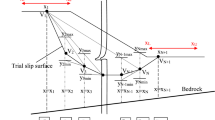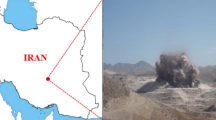Abstract
The study of the stability of rock slope is very important because its instability can cause large disasters. Because the main influence factor of the stability of rock slope is the geological environment, the engineering experience analogy method is a practical and extensively applied method. The main feature of the engineering analogy method is the cluster. Based on the analysis of a dataset of rock slope samples and using the engineering analogy method in relation to the abstraction ant colony clustering algorithm, a new method for rock slope stability analysis is proposed. Using this method, rock slopes can be automatically clustered to obtain the stability status of rock slopes in one class. Therefore, the class rating can represent the stability status of rock slopes. Some real engineering examples are used to verify the computing effect of the new algorithm. Engineering applications prove that this new algorithm can automatically estimate the stability of rock slope with high validity. Its robustness surpasses the robustness of traditional algorithms, and its application is more convenient than that of traditional algorithms. However, as a heuristic algorithm, the selection of algorithm parameters is sometimes challenging, and the computation effect for a highly complex problem is not satisfactory. Therefore, this practical method of slope stability analysis should be popularized.
Similar content being viewed by others
References
Alejano LR, Ferrero AM, Ramírez-Oyanguren P, Álvarez Fernández MI (2011) Comparison of limit-equilibrium, numerical and physical models of wall slope stability. Int J Rock Mech Min Sci 48:16–26
Ashish G, Anindya H, Megha K (2008) Aggregation pheromone density based data clustering. Inf Sci Int J 178:2816–2831
Bieniawski ZT (1989) Engineering rock mass classifications. Wiley, New York
Bonabeau E, Dorigo M, Theraulaz G (1999) Swarm intelligence: from natural to artificial system. Oxford University Press, New York
Cheng MY, Roy AFV, Chen KL (2012) Evolutionary risk preference inference model using fuzzy support vector machine for road slope collapse prediction. Expert Syst Appl 39:1737–1746
Choobbasti AJ, Farrokhzad F, Barari A (2009) Prediction of slope stability using artificial neural network (case study: Noabad, Mazandaran, Iran). Arab J Geosci 2:311–319
Daftaribesheli A, Ataei M, Sereshki F (2011) Assessment of rock slope stability using the Fuzzy Slope Mass Rating (FSMR) system. Appl Soft Comput 11:4465–4473
Das SK, Biswal RK, Sivakugan N, Das B (2011) Classification of slopes and prediction of factor of safety using differential evolution neural networks. Environ Earth Sci 64:201–210
Deneubourg JL, Goss S, Franks N (1991) The dynamics of collective sorting: robot-like ant and ant-like robot. In: Proceedings of first conference on simulation of adaptive behavior: from animals to animats. MIT Press, New York, pp 356–365
Duncan CW, Chris M (2004) Rock slope engineering, 4th edn. CRC Press, Boca Raton
Gao W, Yin ZX (2011) Modern intelligent bionics algorithm and its applications. Science Press, Beijing (in Chinese)
Hoek E, Bray J (1981) Rock slope engineering. Institution of Mining and Metallurgy, London
Hudson JA (1992) Rock engineering systems, theory and practice. Ellis Horwood Ltd, Chichester
KhaloKakaie R, Zare Naghadehi M (2012a) Ranking the rock slope instability potential using the interaction matrix (IM) technique; a case study in Iran. Arab J Geosci 5:263–273
KhaloKakaie R, Zare Naghadehi M (2012b) The assessment of rock slope instability along the Khosh-Yeylagh Main Road (Iran) using a systems approach. Environ Earth Sci 67:665–682
Li AJ, Lyamin AV, Merifield RS (2009) Seismic rock slope stability charts based on limit analysis methods. Comput Geotech 36:135–148
Liang R, Pensomboon G (2010) Multicriteria decision-making approach for highway slope hazard management. J Infrastruct Syst 16:50–57
Lin HM, Chang SK, Wu JH, Juang CH (2009) Neural network-based model for assessing failure potential of highway slope in the Alishan, Taiwan area: Pre and post-earthquake investigation. Eng Geol 104:280–289
Liu YC, Chen CS (2007) A new approach for application of rock mass classification on rock slope stability assessment. Eng Geol 89:129–143
Lu P, Rosenbaum MS (2003) Artificial neural networks and grey systems for the prediction of slope stability. Nat Hazards 30:383–398
Luc S, Frederic-Victor D (2012) Modelling progressive failure in fractured rock masses using a 3D discrete element method. Int J Rock Mech Min Sci 52:18–30
Manouchehrian A, Gholamnejad J, Sharifzadeh M (2014) Development of a model for analysis of slope stability for circular mode failure using genetic algorithm. Environ Earth Sci 71:1267–1277
Rozos D, Bathrellos GD, Skillodimou HD (2011) Comparison of the implementation of rock engineering system and analytic hierarchy process methods, upon landslide susceptibility mapping, using GIS: a case study from the Eastern Achaia County of Peloponnesus, Greece. Environ Earth Sci 63:49–63
Sakellariou MG, Ferentinou MD (2005) A study of slope stability prediction using neural networks. Geotech Geol Eng 23:419–445
Samuia P, Kothari PD (2011) Utilization of a least square support vector machine (LSSVM) for slope stability analysis. Sci Iran Trans A Civ Eng 18:53–58
Siad L (2003) Seismic stability analysis of fractured rock slopes by yield design theory. Soil Dyn Earthq Eng 23:203–212
Stead D, Eberhardt E, Coggan JS (2006) Developments in the characterization of complex rock slope deformation and failure using numerical modelling techniques. Eng Geol 83:217–235
Sun Y, Zhu QM, Chen ZX (2002) An iterative initial-points refinement algorithm for categorical data clustering. Pattern Recognit Lett 23:875–884
Tian LJ, Wang LS, Liu SK (1992) Bank stability of Three Gorges project. China Science and Technology Press, Beijing (in Chinese)
Xia YY, Xiao F (2000) Evaluation of slope stability based on one self-adaptive clustering method. In: Proceedings of 6th rock mechanics and rock engineering. China Science and Technology Press, Beijing, pp 562–565 (in Chinese)
Xie QM, Xia YY (2002) A self-adaptive clustering method based on the simulated annealing algorithm for evaluation of slope stability. J Catastrophol 17:15–19 (in Chinese)
Zare Naghadehi M, Jimenez R, KhaloKakaie R, Jalali SME (2011) A probabilistic systems methodology to analyze the importance of factors affecting the stability of rock slopes. Eng Geol 118:82–92
Zare Naghadehi M, Jimenez R, KhaloKakaie R, Jalali SME (2013) A new open-pit mine slope instability index defined using the improved rock engineering systems approach. Int J Rock Mech Min Sci 61:1–14
Acknowledgments
The financial supports from The Fundamental Research Funds for the Central Universities under Grant No. 2014B17814 and 2014B07014 are gratefully acknowledged.
Author information
Authors and Affiliations
Corresponding author
Rights and permissions
About this article
Cite this article
Gao, W. Stability analysis of rock slope based on an abstraction ant colony clustering algorithm. Environ Earth Sci 73, 7969–7982 (2015). https://doi.org/10.1007/s12665-014-3956-4
Received:
Accepted:
Published:
Issue Date:
DOI: https://doi.org/10.1007/s12665-014-3956-4




